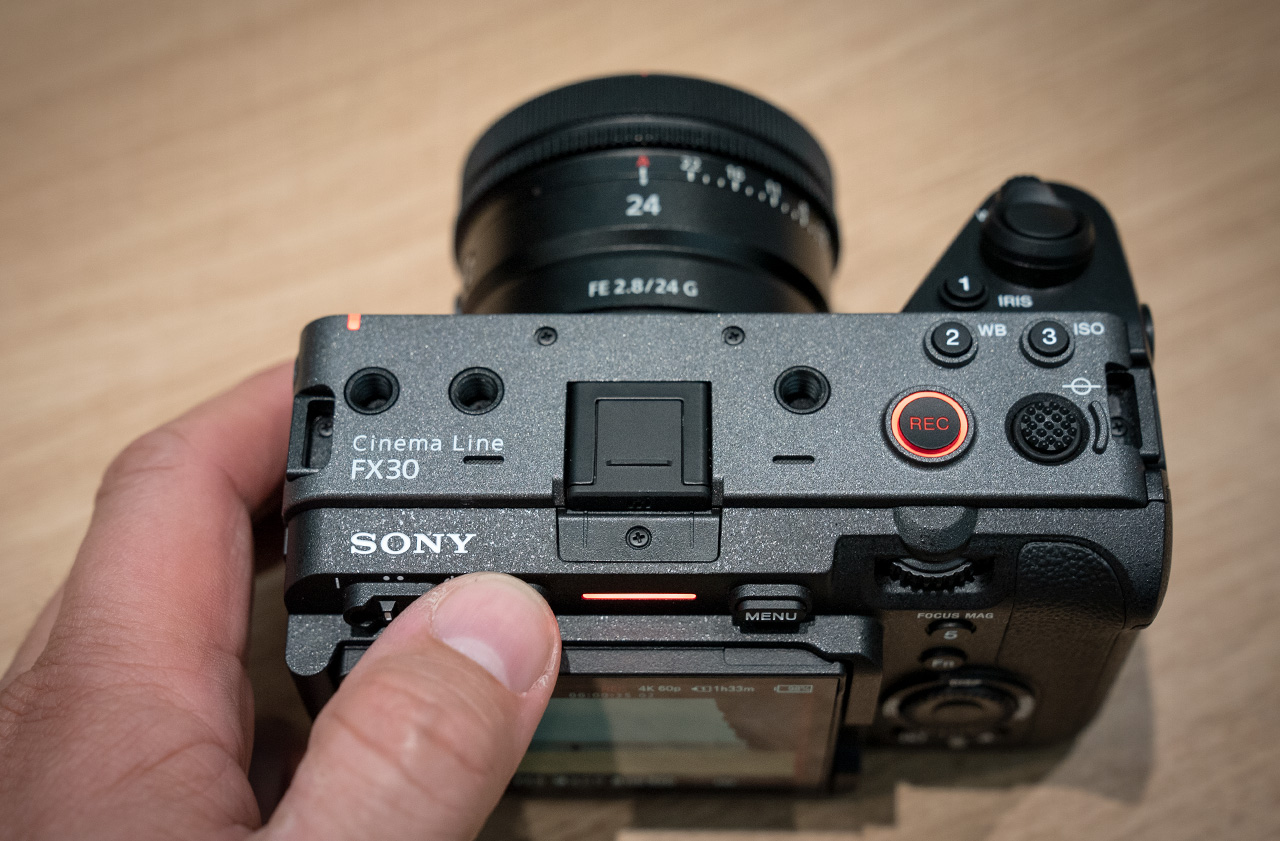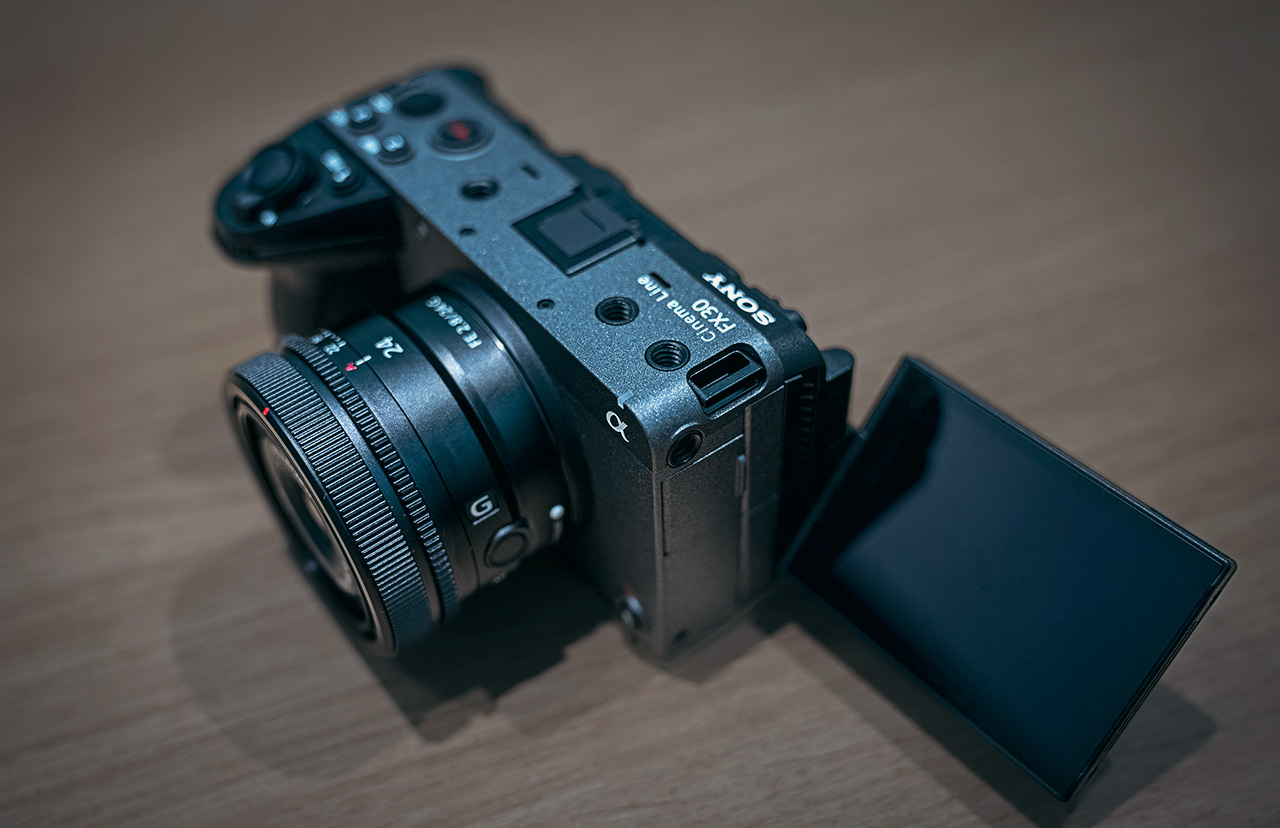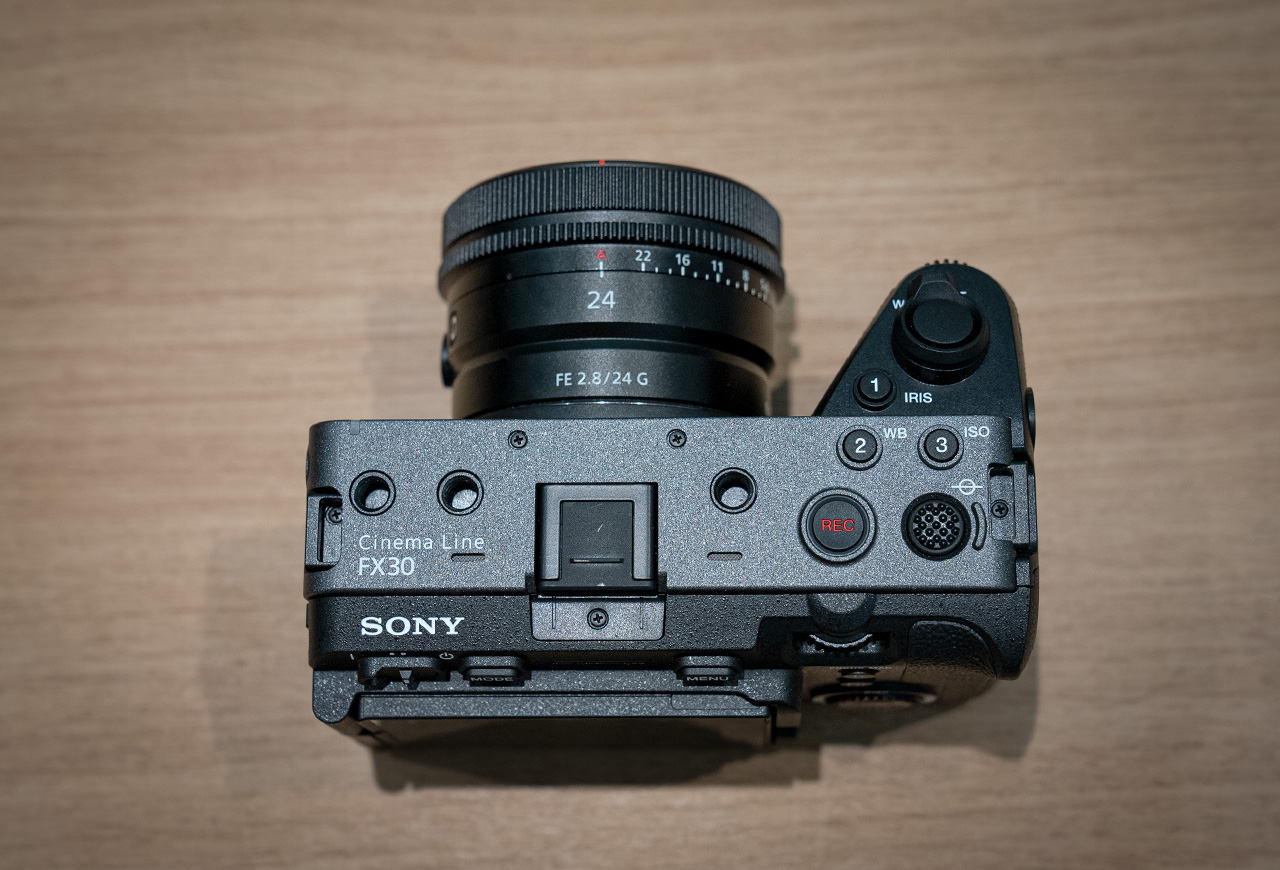During IBC 2022 we had the chance to be one of the very few people outside of Sony that had a chance to briefly try out the new FX30 camera and also talk to Mr. Yann Salmon-Legagneur, the Director of Product Marketing & Professional Business Strategy at Sony Europe to ask a few brief questions about the camera.
This was actually our second interview with Mr. Salmon-Legagneur at the show, the more comprehensive general interview where we discuss a broad range of topics will be published here soon.
The Sony FX30 in our hands at IBC 2022
Sony FX30 VS. Sony FX3 Main Changes
While the body of the FX30 looks almost identical to that of the FX3 (the FX30 is about 80g lighter), with five 1/4″ 20 mounts, a top handle with XLR connections, and no EVF, there are some important differences between the two cameras.
The most obvious one is the sensor. The FX30 uses a 26MP APS-C BSI sensor – one which is completely new to the Sony lineup and was never used before on any Sony camera. The sensor has a lower official dynamic range compared to the one in the FX3 (14 stops vs. over 15 stops) and is far less sensitive (100-32,000 ISO vs. 80–102,400 of the FX3).
On the bright side, the FX30 has not only Dual ISO but also Dual Base ISO (which the FX3 and even FX6 lack), and the regular dual ISO is 800/2500. You also get the most recent features like focus assist map and focus breathing compensation (see more on that below) and animal and birds eye AF which is lacking from most other Sony cameras.
Same body type and design as the FX3 with an internal fan and no viewfinder
The FX30 has only an electronic shutter and can do only single-frame shooting (the FX3 can do 10fps and has a mechanical shutter like the A7S III) and it also lacks flash support (this camera unlike the FX3 which borrows much from the A7S III which is a hybrid camera was designed from the ground up to be a video camera with pretty limited stills capabilities).
Like the FX3, the new FX30 can shoot up to 4K 120p (with a tiny 1.1X extra crop over the APS-C of the sensor) in 10bit 4:22 and it uses a similar built-in 5-axis image stabilization, same Z-type battery, dual SD/CF-A memory card setup, zoom lever in the front, and tally lights like the FX3. It is also dust and moisture-resistant like the FX3.
From the menu side, the camera uses the same modern menu structure as all the other Sony cameras but adds a special screen that shows all the important camera settings like frame rate, shutter speed, and aperture. color temperature log, audio settings etc.
Another small but important improvement is a screen mode where most of the information is not shown on the image itself but above or below (allowing the user to better see the frame), this is something that you can find in higher models like the Venice.
There are also some improvements to the data shown in the metadata of Catalyst browse (camera rotation info, shot marks, breathing compensation info, stabilization, and LUTs), and maybe even more interesting Sony will now be offering a Premiere Pro plug-in of the Catalyst software (Sony was not willing to commit on similar plug-ins for other software at this point). The LUT info is of particular interest as it will be automatically added to the video (you will always be able to change this in post if you want).
The FX30 will also be the first camera to support breathing compensation up to 120p in post (using the breathing compensation metadata mentioned above). Like other cameras, it will be able to fix this info in-camera up to 60p.
Mind you, the plugin for Adobe will come in two versions – a free one and a paid version ($100 a year). The difference between the two is that the breathing compensation and gyro stabilization correction will work with a watermark in the free version (for testing). We have to be honest here and say that we really don’t care for this move from Sony as these are not really extra features and you can use them for free in the none-plug-in version of Catalyst Browse.
Articulated monitor on the FX3 (the camera will come in two versions with and without the XLR+handle)
FX30 Q&A with Sony
The interview above was shot during IBC 2022 (almost 3 weeks prior to the actual FX30 announcement) and we got lucky to be able to play around with the FX30 pre-production model and ask Mr. Salmon-Legagneur a few questions about the camera.
- First, we wanted to know who is the target audience for the new camera, from Sony’s perspective. The short answer provided to us by Mr. Salmon-Legagneur was that the target audience of the FX30 is aspiring content creators and filmmakers and it is designed to still be part of the FX family but as an entry-level product.
- We already touched on that topic above but we wanted to hear Mr. Salmon-Legagneur’s answer regarding the differences between the FX30 and FX3. He emphasized in his answer the difference that the sensor size actually makes. While the FX3 has a better dynamic range, more background separation, and better ISO performance, the FX30 with its higher resolution sensor (26MP vs. 12MP of the FX3) allows the camera to oversample from 6K, something that the FX3 can’t do. There are some aspects that are unique to the FX30 compared to the FX3 and those are actually inherited in a way from the top-of-line Venice and FX9 cameras (this refers to the dual base ISO of 800 / 2500 ISO which offers the same noise at both ISOs). There is also Cine EI quick which is a faster way of setting the ISO automatically. The camera also has eye AF for humans and animals in video mode and a focus map and breathing compensation as well as active mode stabilization.
- We wanted to be sure that this is a new sensor and how it compares to the most recent (kind of old now) A6600 sensor – Mr. Salmon-Legagneur confirmed that this is a new sensor and said that comparing it to the A6600 is difficult since there have been so many technological advancements since the release of that sensor that the two are really different (does that mean that a 26MP stills APS-C camera is coming? we will have to wait and see).
- Finally, we wanted to ask if Sony sees any market need for a mini FX6 style camera body (the FX3 and FX30 have a “stills” style mirrorless body while the FX6 and FX9 have more of a traditional video camera style body). The short answer is not really and not just because the market apparently isn’t asking for such a camera body but also because making one will probably be very expensive which doesn’t make a lot of sense for the target audience according to Mr. Salmon-Legagneur.
The most affordable Sony Cinema camera yet
Pricing and Availability
The Sony FX30 will be available in October 2022 for a price of $2200 with the XLR top unit and handle or $1800 as body only.
For more of our coverage on LensVid from IBC 2022 – please visit the following link.

You can support LensVid by shopping with our affiliate partners
Affiliates: Amazon, B&H, Adorama and E-bay.
Why should you trust us?


